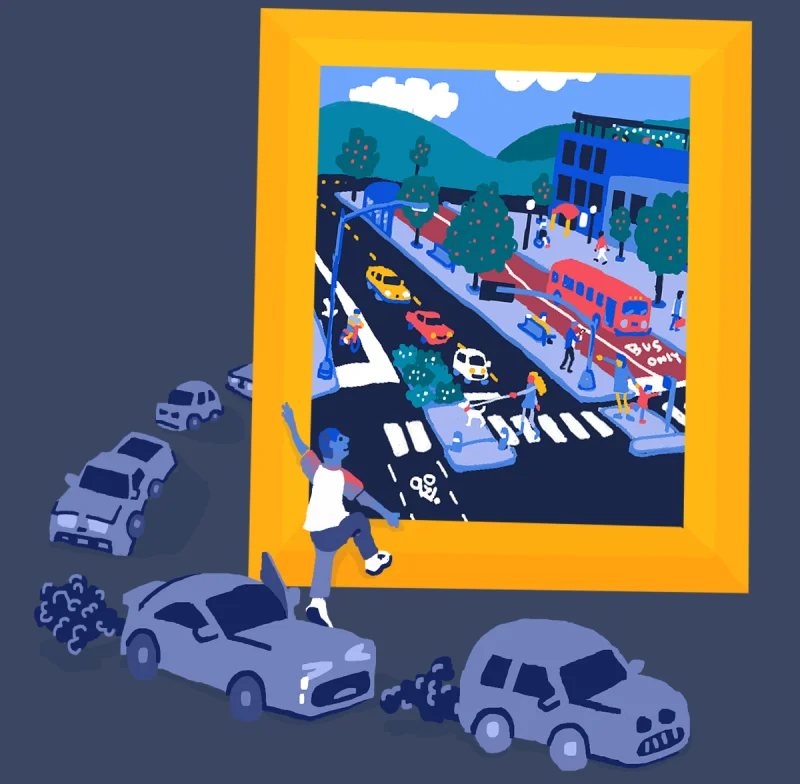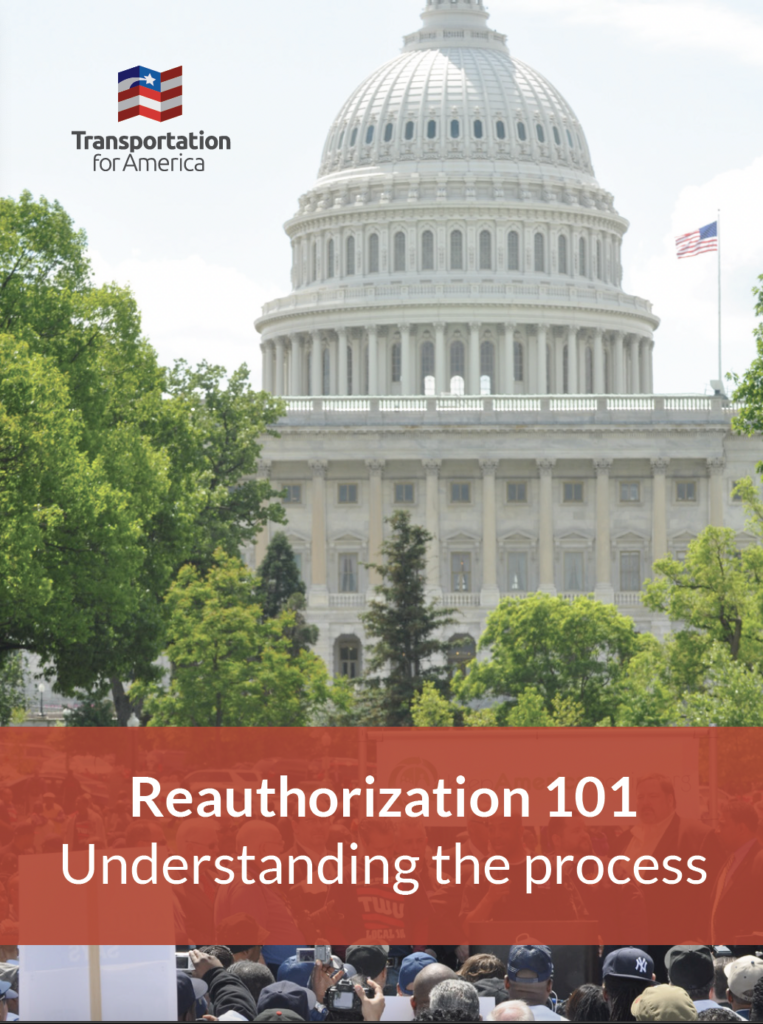Policy platform
Our proposals for transportation reauthorizationThe ~$77-billion-per year federal transportation program has been limping along for years, accomplishing very little while requiring enormous taxpayer infusions to cover its costs. This program doesn’t need a facelift; it needs to be blown up and replaced with something completely new.

Replace the failing, bankrupt federal transportation program with something new
Transportation for America’s policy proposals for reauthorization are focused on radically updating this program and making it more accountable to taxpayers. This package of policies are not simply a menu of à la carte choices for improving things at the margins—these proposals are an interwoven package of essential reforms to build an entirely new federal transportation program from the ground up.

What is "reauthorization?"
Surface transportation reauthorization is a shorthand term for the federal legislative process where the federal surface transportation program is renewed—setting all policies, priorities, and funding levels for multiple years to come. It typically happens every 5-7 years. The current law expires in September 2026 but this process is already underway. If you are new to “reauthorization,” read our short guide to get started.
Two reasons for ending the program as we know it:
1) The program is failing to deliver on its promises
The federal government has spent $1.5 trillion of American taxpayer dollars over the past 30-plus years with primary goals of improving safety and infrastructure conditions, reducing congestion, and protecting the environment and public health. Yet this bipartisan approach is failing on all fronts—in spite of a historic increase in funding several times over, including the mammoth increases in the 2021 Infrastructure Investment and Jobs Act.
Safety got worse: The United States has the most dangerous roads in the developed world, 20 percent more deadly than Chile, twice as deadly as Greece, and six times as deadly as Norway. Most peer countries are getting safer, while U.S. road safety marginally improved until COVID, and now we celebrate slight decreases in fatalities from a tragic high in 2021. For people walking, it’s even worse. Compared to a 29 percent improvement in the rest of these countries, pedestrian fatalities in the U.S. have increased 75 percent since 2010, which you can find in the National Complete Streets Coalition’s report on pedestrian safety, Dangerous by Design.
Infrastructure conditions stayed about the same: USDOT’s Conditions and Performance Report for 2024 found that the share of federal-aid highway pavements with good ride quality improved during the 2008–2018 period, from 40.7 percent to 47.2 percent. But the share of federal-aid highway pavements with poor ride quality also increased during that time, rising from 15.8 percent to 22.6 percent. In terms of bridges, the share of federal-aid bridges in good repair decreased from 47.8 percent to 46.0 percent; however, the share of federal-aid bridges in poor repair also decreased from 10.1 percent to 7.6 percent. Even the country’s civil engineers agree that America’s roads, bridges, safety, and transit are about the same as 20 years ago: lackluster.
Congestion got worse: Between 1993 and 2017, the largest 100 U.S. cities added 30,511 new freeway lane-miles, an increase of 42 percent. That rate of freeway expansion significantly outstripped the 32 percent growth in population in those regions over the same time period. And congestion skyrocketed by 144 percent. Congestion increased in every single one of these 100 metro areas, even in places that lost population and built more highway capacity. Fewer people, more highways, and congestion increased—a lot!
Emissions got worse: Based on current investment patterns, over the course of the current infrastructure law, federal surface transportation investments could increase emissions by nearly 190 million metric tonnes of emissions over baseline levels, which is the equivalent of nearly 50 coal-fired power plants running for a year. And we weren’t doing well before the IIJA either, as we showed in our 2020 report, Driving Down Emissions. The transportation sector is a top emitter.
2) The “user pays” trust fund concept has been dead for 15 years
Despite these failing results and the fact that Congress spends approximately $20 billion more per year than the gas tax brings in, the federal surface transportation program enjoys a special budgetary privilege accorded to programs covered by user fees. Namely, the program’s revenues are placed in a protected trust fund that cannot be touched in the annual appropriations process, providing transportation agencies long-term funding certainty. But these user fees haven’t come close to covering the cost of the program since 2008, requiring infusions of extra tax dollars from all Americans totaling more than $280 billion to cover the gap in that time. The trust fund as we have known it doesn’t exist; it is a trust fund in name only that is failing to deliver results.
The stability at the heart of a trust fund approach further eroded in early 2025 when the new Trump administration broke with precedent by delaying funded projects, requiring grantees to change their projects, and slow-walking or refusing to reimburse already awarded project sponsors. This is the opposite of certainty, so why have a trust fund? In fact, considering the extra-legal actions being taken at USDOT, Congress should begin reviewing USDOT’s actions more closely every single year.
The conclusion is clear: transportation should no longer be eligible for a trust fund. End the trust fund, and let’s consider whether the federal surface transportation program is performing well enough to get this kind of money, or if it might be better spent elsewhere. If this program is worth saving, it needs to be radically updated and made accountable to the taxpayer.
Our (individual) proposals below are not a menu of ideas for Congress to choose from and graft onto the existing program. They are an interwoven package of essential reforms needed to bring this outdated and failing program into the 21st Century. Without this comprehensive approach, additional federal funding would be a waste of the taxpayers’ money.
View individual policy briefs below
In addition to the full bundle linked above, you can read and download only the individual proposals for each specific policy area below. The proposals are organized around our three principles, plus the additional goal of modernizing the federal program.
FIX IT FIRST
Prioritize existing maintenance needs
If your house has a leaky roof, you fix that before remodeling your kitchen. The federal transportation program should do the same and prioritize existing maintenance needs ahead of building new things, which require decades of additional repair costs. Read more >>
Rebuild local economies by reconnecting communities
Interstates and other highways have divided neighborhoods, wreaked havoc on local economies, and harmed the health of those living nearby. It’s time to repair this damage while ensuring that we stop making the problem worse. Read more >>
INVEST IN THE REST
Build world-class transit in communities of all sizes
Americans deserve world-class transit that connects people and unlocks economic opportunity. Congress should help communities build the next generation of transit by funding it like highways and investing in the neglected half of our transportation network. Read more >>
Build a world-class passenger rail network
We need to preserve our existing national and regional passenger rail networks, invest in repairing and expanding rail infrastructure, ensure on-time service, and support operations. Doing so will require the kind of stable, sustained, multi-year funding that highways have received for 70 years. Read more >>
Invest in the growing electric vehicle (EV) market
The U.S. should support and grow the domestic EV industry, create jobs, and catalyze market demand by developing a comprehensive charging network that aligns with local priorities and user convenience. Read more >>
DESIGN FOR SAFETY OVER SPEED
Stop prioritizing speed over safety
Reversing the alarming trend in traffic deaths—especially for people walking and others outside of vehicles—will require a paradigm shift to put safety first not just in word, but in deed. It’s time to use the power of design to prioritize safety. Read more >>
Ensure autonomous vehicles (AVs) meet the promise of their potential
While AVs—already operating on our roads—promise to improve safety and access, we need to recognize that every technological solution creates new problems. Without more intentional guardrails, AVs could endanger public health, safety, and the environment. Read more >>
MODERNIZE THE PROGRAM
Hold agencies accountable to the taxpayer
This program will fail to bring a positive return on investment until we begin holding agencies accountable for accomplishing specific, measurable goals with the billions we provide to them. We can’t do that without better, more current data to hold those in power accountable for years of failing grades. Read more >>
Bring the federal program into the 21st century
Americans spend more money driving farther to accomplish less. This failure is partially due to our reliance on outdated 1950s measures and standards that focus on moving cars quickly at the expense of safety and access to jobs. Read more >>
Get to know our three simple principles:
Any serious effort to reduce deaths on our streets and roads requires slower speeds. Federal funding should require approaches and street designs that put safety first.
Related Resources
If your house has a leaky roof, you fix that before remodeling your kitchen. The federal transportation program should do the same and prioritize existing maintenance needs ahead of building new things which require decades of additional repair costs.
Related Resources
For 60 years we’ve invested hundreds of billions of dollars in highways. Now it’s time to invest in the rest to create a complete transportation network so more Americans can safely travel by foot, bike, bus, or train.
Related Resources






